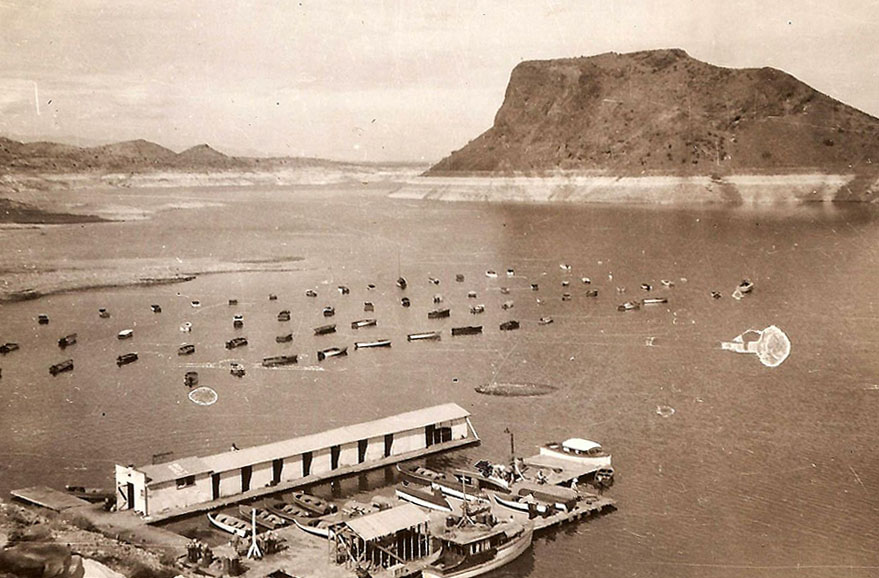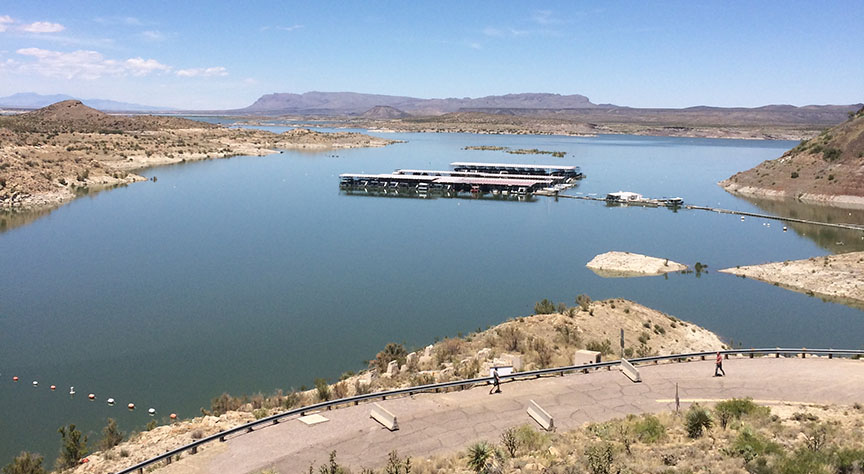

Beginning in the 1880s, farmers in west Texas complained that the Rio Grande was down to a “trickle of water” during the summer. The blame was placed on the farmers upstream in New Mexico. The solution was to build a dam…but where to locate it and how to fund it would take the next 30 years.
Sites close to El Paso were considered first, but flooding the Mesilla Valley’s rich agricultural land seemed a bad idea. The northernmost site considered was Elephant Butte. A feasibility study done in 1902 settled the question, and Elephant Butte was chosen as the site.
Funding had been another question. British investors got involved in the 1890s but, due to delays, lost interest. The ultimate construction was U.S. funded with the idea that irrigators would over time pay off the costs. This never happened. Construction was finally started in 1911 and completed five years later. It was claimed to be the second largest irrigation dam in the world. What has happened since?
The dam was first named Elgin for an engineer who had worked on the construction, but later it was changed to Elephant Butte for a volcanic rock intrusion which looks like an elephant lying on its side.
In 1938, the Rio Grande Compact between Colorado, New Mexico, and Texas was finalized by Congress. Elephant Butte became the delivery point for Texas’s share of Rio Grande water, in spite of it being over 100 miles north of the Texas border. This has proven to be problematic, as currently only 10% of the Elephant Butte reservoir is full. This leaves few options for New Mexico to deliver the required water to Texas. The last year the reservoir had sufficient water for a ‘normal’ release to Texas was 2003. Texas is currently suing New Mexico in the US Supreme Court for allegedly taking too much ‘Texan’ water below the dam. The “trickle of water” is again happening, all these years later.

Elephant Butte Reservoir. May, 2017. Photo: Ken Gingerich: mid Rio Grande Times
One of the major areas of contention is the amount of evaporation from standing bodies of water such as the dam, and how to measure this. Evaporation, precipitation, and runoff are all parts of the normal water cycle. Evaporation, however, accounts for more freshwater loss than household and industrial use combined. People are trying various ideas to decrease evaporation. For example, in one California study, they found floating solar panels to be a useful barrier to sun exposure, while also providing electricity for the grid.
The US Army Corp of Engineers (USACE) is tasked with estimating evaporation in order to inform water budgeting and planning. Average daily air temperature, relative humidity, wind speed, and solar radiation are all taken into consideration using various means of measurement and complex formulas for final calculations but there is no doubt that there is an increased rate of evaporation everywhere from standing bodies of water. In one recent US Supreme Court decision, it was decided that Texas had no right to one third of the water they claimed in a New Mexican reservoir secondary to its loss to evaporation.
What is the future for Elephant Butte? The dam is now over 100 years old. As one engineer said, a dam begins to die the year it is finished – that’s when sediment build-up begins. The USACE issues contracts for sediment removal for dams but not all can be removed. As our region faces changes caused by climate change and shifting population patterns, we will need to examine closely our reliance on dams and how they shape our region and out fresh water supply.


I appreciate all this historical info on the Elephant Butte Dam. I was surprised to learn how much water loss is attributed to evaporation, though I suppose some of that evaporation goes into creating clouds and rainfall. I guess evaporation mitigation could be an area ripe for creative solutions as we consider climate change. Thanks for publishing it.